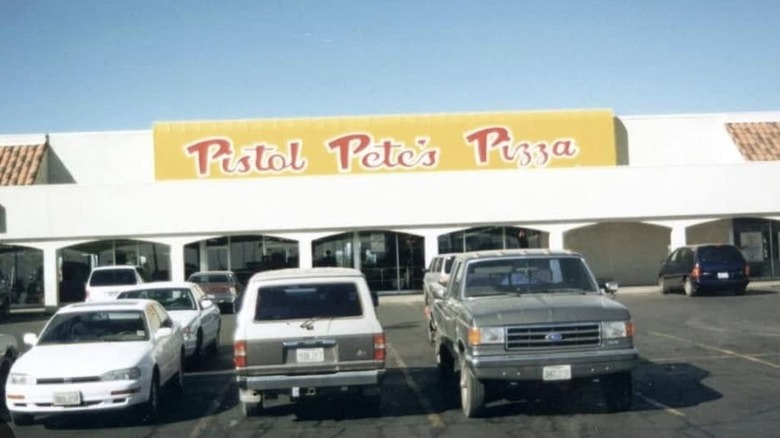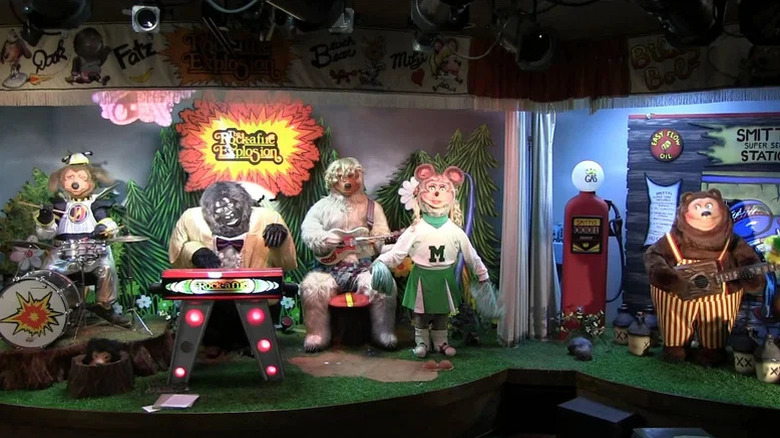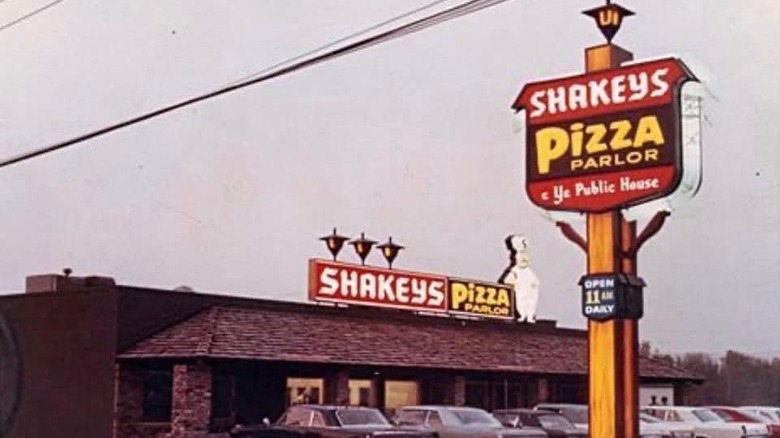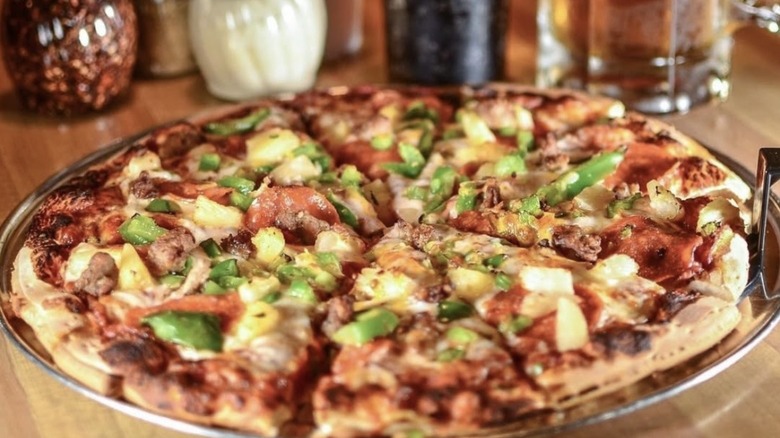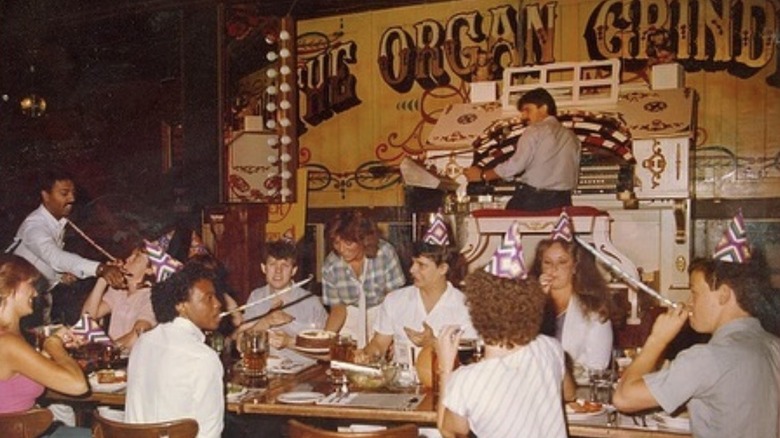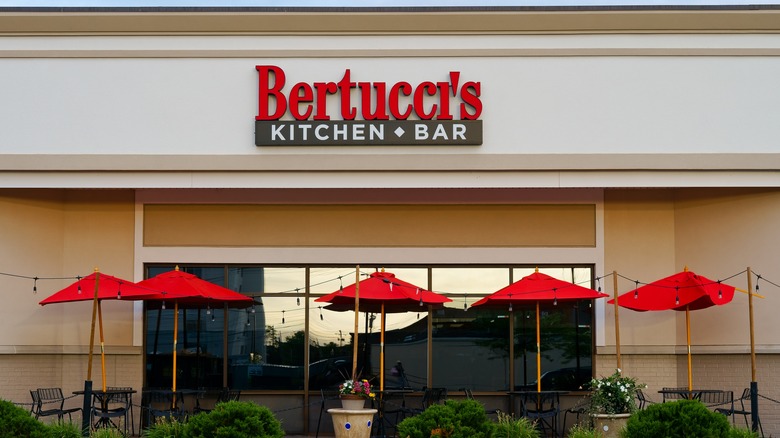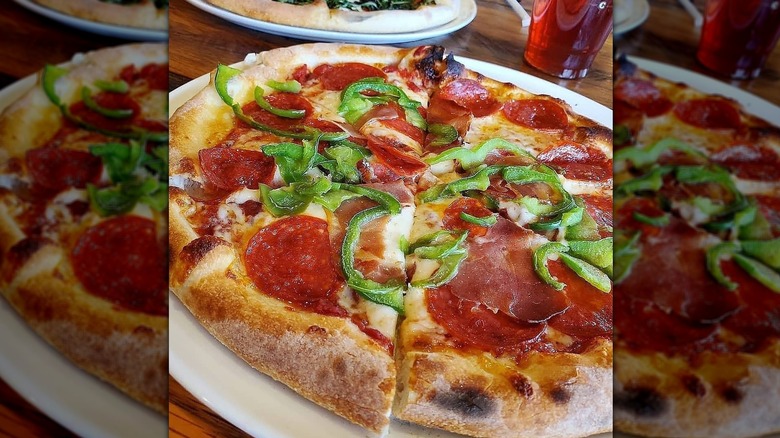9 Old-School Pizza Chains That Have Vanished
Pizza is a universal favorite, from an easy weeknight dinner to a celebratory meal. Countless pizza chains have opened up across the country through the years, with many becoming favorites to local pizza connoisseurs. Each restaurant has created its own take on the staple dish, trying to stand out from the numerous others. Some are known regionally, while others blow up and become known nationwide.
For every successful pizza chain, there were many others that simply couldn't stand the test of time. Some fell victim to financial difficulties, while others were the target of severe lawsuits. Yet more were simply phased out due to changing customer tastes and dining habits. Many fast casual establishments were out-priced by their ever-growing competitors, and other themed chains were not able to compete with a faster-growing version of their own establishment. These chains remain a nostalgic memory to those who frequented them, even though they were eventually forced to close their doors or are on their way to doing so.
Pistol Pete's Pizza
In a recent closure, Pistol Pete's — named for the Oklahoma State mascot — closed its doors in mid-2024. This popular family dining chain combined great pizza with arcade-style games and entertainment. Peter Piper Pizza took over the chain in the late 1990s, but customers continued to support the business and show their loyalty to the brand. At its most popular, Pistol Pete's was an affordable, fun choice for the entire family.
After Pistol Pete's became Peter Piper Pizza, sales stabilized for several years until the group faced competition with Chuck E. Cheese. Declining sales put a dent in the restaurant's profits, as did people not dining out as often and making their pizza at home, even after restrictions began to ease. In the middle of 2024, Pistol Pete's officially declared it could not recover from the losses and shut its doors. Some of the locations were even transformed into Chuck E. Cheese restaurants, demonstrating that there just was not a large enough market for too many of the same type of dining franchise.
ShowBiz Pizza Place
Themed restaurants were extremely popular in the 1980s. ShowBiz Pizza was one such place, and came complete with singing animatronics that serenaded you as you ate. The animatronic band was known as the Rock-afire Explosion and was known to families across the country. This feature was brand-new in dining establishments and kept families coming back, with their children loving the fun twist on casual dining.
Despite its prominent success early on, ShowBiz Pizza Place faced fierce competition once Chuck E. Cheese hit the scene, offering a near-identical experience, complete with singing, dancing animatronics, but at a much cheaper price point — it eventually became so popular that it came out with frozen pizzas to make at home, and its pies were sold in ghost kitchens in several states. ShowBiz was unable to keep up and eventually had no choice but to merge with the more successful company. For those in a younger generation, Chuck E. Cheese is the place known for singing animals, but ShowBiz Pizza Place remains a nostalgic memory for those from older people who grew up eating there, wanting a slice of old-school pizza.
Shakey's Pizza Parlor
Shakey's Pizza Parlor was truly an institution for a time, eventually spanning over 500 locations worldwide after its opening in 1956. Shaky's wasn't just your average pizza spot — here you could enjoy great food, live music, and festive decorations. Servers dressed in costumes, and this helped the chain stand out from other pizza restaurants that were also growing in popularity. Through the '60s and '70s, many made Shakey's a weekly outing; for many, this was the main place they went out for dinner.
While it held strong for a few decades, eventually, Shakey's began to struggle. Large corporations like Pizza Hut and Domino's were starting to grow in size, and franchises were popping up in towns across the nation. This abundance of stores meant that they could also charge much less than smaller brands like Shakey's, making it hard to keep up. Pizza Hut and Domino's also offered quicker meals that you could have delivered, which customers seemed to care more about than the fresh ingredients offered by smaller chains. By 2025, fewer than 50 Shakey's Pizza Parlors remain open, and there are plans to permanently close its doors by the end of the year.
Straw Hat Pizza
Straw Hat Pizza opened its first restaurant in California in 1960. The restaurant quickly became a state favorite thanks to its fresh ingredients, unique flavors, and thin, hand-tossed crust. As the casual dining scene took off around America, Straw Hat opened several more brick-and-mortar locations around California and beyond. Straw Hat thrived on community members hosting birthday parties, sports gatherings, and other group events.
Straw Hat was steadily beating out competition for a number of years, but it experienced several changes of ownership over a period of time that stunted its expansion. Without swift expansion, larger companies once again bulldozed the underdog that couldn't keep up. Pizza Hut tried to absorb Straw Hat, but the owners engaged in a rough legal battle that Straw Hat eventually won, letting the chain persist a bit longer. Still, Straw Hat faces a swift decline. Only about 24 Straw Hat Pizza restaurants remain today, all of them in California. Many Straw Hat restaurants have been sold in favor of new businesses, but some fans still keep the doors open for a small number of shops.
My Pi
My Pi was the king of pizza joints for someone who knew where to look. Founder Larry Aronson opened his doors in 1971, dedicated to sourcing the best ingredients and serving the freshest pizza to the people of Chicago. Customers flocked to My Pi and it was soon known as one of the main pizza spots in the area, with Chicago-style pizza one of the most popular types of pizza in the country. This place was a hidden gem, with the undying work to perfect crust, sauce, and toppings shining through.
Even though My Pi had a large and loyal following, artisanal pizza joints began popping up all over Chicago and beyond. Many got celebrity endorsements as Chicago-style pizza grew in popularity. There were more small shops, of course, but larger companies made ingredient prices soar, and it was difficult to keep up with the deals they offered while still sourcing fresh and local ingredients. After over 50 years, My Pi announced its closing in 2025, shattering the hearts of many local fans. The closing of this particular restaurant was truly the end of an era in Chicago dining.
Eatza Pizza
Eatza Pizza quickly broke apart from the casual dining pack when it announced its buffet-style restaurants. This chain promised all-you-can-eat pizza, salad, pasta, and desserts, and this model attracted families looking for a quick meal as well as large groups celebrating any number of occasions. The self-serve buffet style was effortless, required minimal staffing, and was quite a hit in the early 2000s when this chain came to be.
The chain, unfortunately, soon started facing both financial and legal troubles. Eatza Pizza was saddled with multiple severe lawsuits that left the company barely staying afloat. While these lawsuits were at their worst, the brand was also sold to a private equity group, leaving the restaurant strapped for cash and unable to pay its legal fees. There was no choice but to file for bankruptcy, and the chain closed its doors. Even as recently as 2025, many pizza chains are filing for bankruptcy. This downfall was sudden, showing that even if a restaurant was extremely popular in its peak, all chains have the possibility of failing.
The Organ Grinder
If you've ever met anyone who's been to The Organ Grinder, they'll tell you it was a trip to remember. As its name suggests, the restaurant featured live organ and other musical performances, with a live band almost every night of the week. Diners could expect arcade games, festively dressed servers, and the entire staff (including the cooks) in costume. This restaurant didn't just feel like you were going out to dinner; it felt like an evening full of entertainment.
Like many other theme restaurants of its day, The Organ Grinder could not last forever. As tastes evolved, entertainment-based dining experiences were phased out in favor of higher-class restaurants. Operational costs were also a battle for The Organ Grinder, and as ingredients and performance costs went up, the chain was unable to keep up. Locations slowly began to close, and Organ Grinders everywhere shuttered the doors. While themed entertainment restaurants surely had their day at one point, they just could not last in the ever-changing dining scene.
Bertucci's
Bertucci's was a Massachusetts staple in 1981 when it opened. The chain spread through the East Coast and became known for its authentic flavor, aided by the massive brick ovens in which its pizzas were cooked. Bertucci's was known for hearty food and an authentic atmosphere, which did well among the myriad seafood restaurants found in Massachusetts and other East Coast states.
Even though Bertucci's was able to expand to over 30 shops throughout New England, in the recent past, the brand has come across financial hardship. Once known as a recognizable name in the eatery scene, Bertucci's has since filed for bankruptcy three separate times; in 2018, 2022, and 2025. Each time bankruptcy was filed, more restaurants closed. Fans were disappointed as fine dining spots like Bertucci's were replaced by fast food and casual dining. A couple of Bertucci's restaurants are still in operation, but the company has stated that closures will continue as it's continually priced out by cheaper pizza options.
Pizza Cucinova
In the early 2010s, fine dining was being overrun by casual meals and fast food. Pizza Cucinova was one such palace, allowing customers to customize their pizza before their very eyes as the pizza was assembled in front of them. This business model is similar to that of Chipotle, Subway, and other build-your-own restaurants. Pizza Cucinova offered a fresh take on fast-casual pizza dining that was perfect for families wanting to end their week with a pizza night.
But many other chains had the same idea, trying to outpace and out-price competitors. Other chains had more resources and could expand much more aggressively than Pizza Cucinova could. The restaurant quietly disappeared without many major announcements by the brand. By 2020, all iterations of the brand had closed, leaving only a legacy. While not as well-known as some of its peers, Pizza Cucinova had a large fanbase that remembered it as a local staple.


